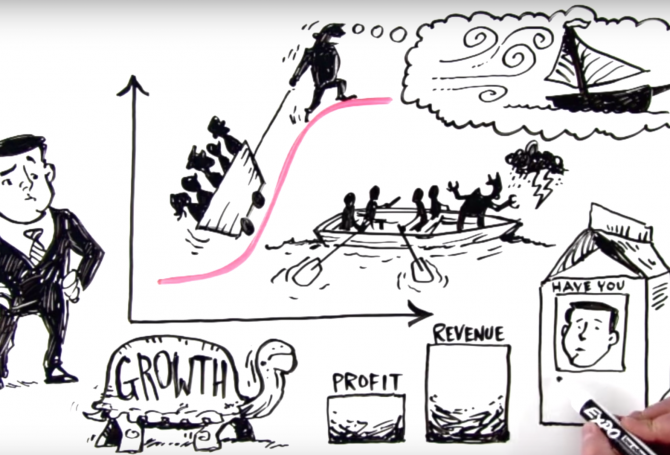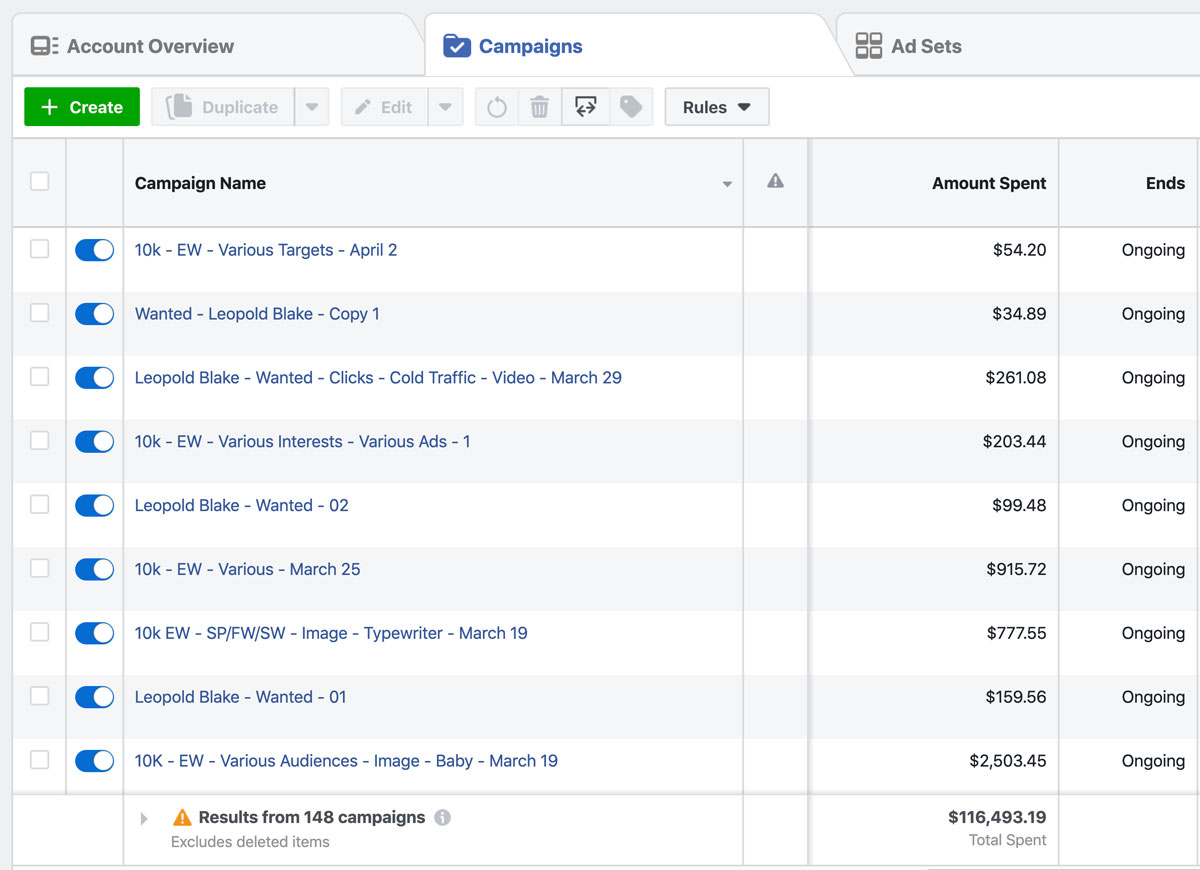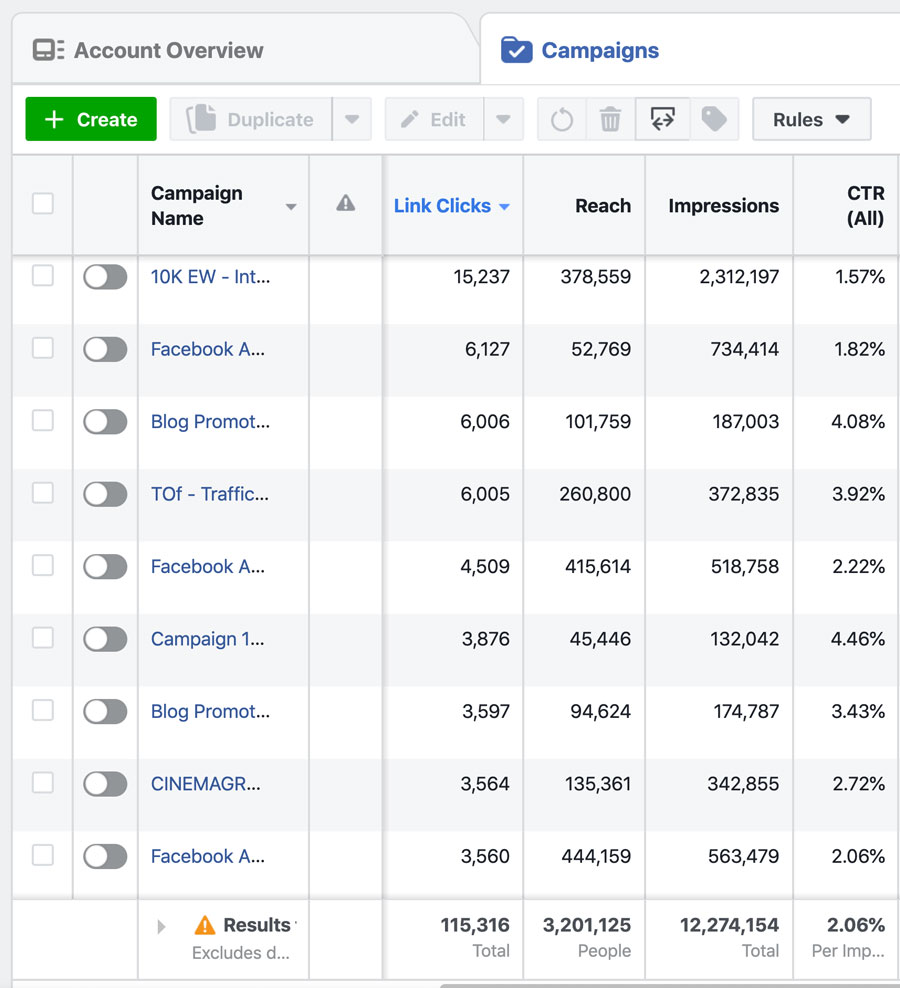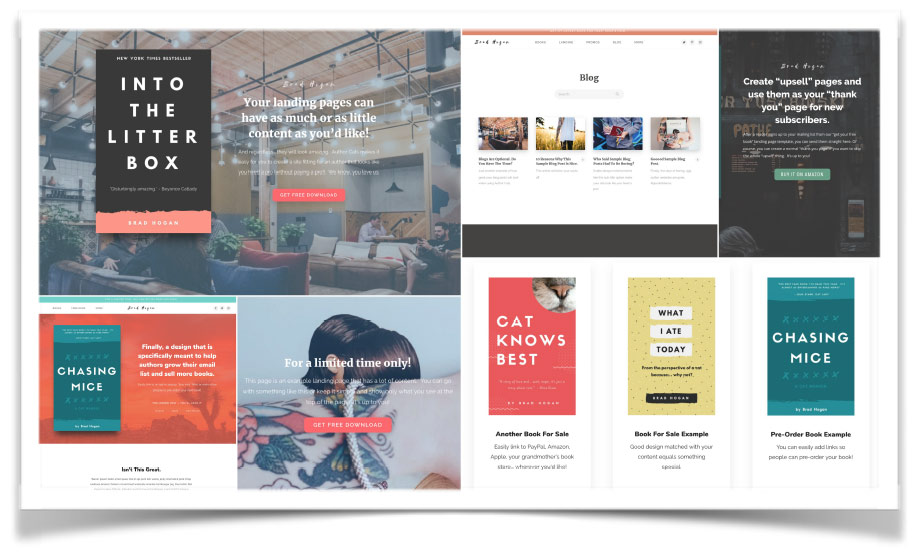How to create, target, optimise, maintain, and scale your paid advertising with Facebook Ads. In this article series, I’ll walk you through my system to generate quality traffic through to your book and website pages, and how to scale up profitably (using a totally new approach).

“Scaling up means constantly seeking and implementing better ways of thinking and acting across old and new corners of the system. ”
It’s no secret that building a successful author career in 2019 requires a “pay to play” attitude. Since Amazon shifted their focus to building an advertising revenue model, it’s proved harder and harder to find sales growth organically on their platform.
A few years ago, an author had a pretty good chance of success if he/she could produce quality books at a reasonable clip, set the first book free, and then sit back and run the occasional Bookbub deal. Amazon’s search algorithms kept things ticking along quite nicely.
Since 2014, I’ve urged authors to look outside Amazon and look at strategies they can use to shift some of the power into their own hands. As organic reach slowly declined, and with the introduction of Kindle Unlimited (and month-on-month reductions in payments – down from around $2.30 per book “borrow” in 2014 to around $1 per 200 pages in 2019), building an engaged email list, running promotions more frequently, joining group promotions, building automated selling systems, and other approaches are more important than ever.
But, of course, building growth systems still relies on three things:
A typical example would be this:
As you would expect, the higher the value of each step, the more results you’ll see overall. More traffic means more people entering your “system”. More conversions means more subscribers. More sales means… well, more sales.
And this is where a lot of authors fall down.

They either don’t have a “system” at all – and have no way of controlling the flow of people to their work – or they have a system, but the numbers don’t work.
Usually, it comes down to:
If you’ve read through our article on building a targeted Facebook ad, chances are you know how to BUILD an advertising campaign – but that’s the easy part. Understanding the CONTEXT of your ads and the STRATEGY you need in order to grow your business is the tricky part.
Over the last couple of years, I’ve spent over $100,000 (of my own money) on Facebook advertising – and made a return of more than $400,000 from those ads, from a combination of non-fiction books, fiction books, courses, and software sales (I try to keep busy…).

And with all that data at my fingertips, I know what works. I also know that THINGS CHANGE ALL THE TIME and you have to nail down your overall strategy to ensure you don’t lose sight of how paid advertising can help your business grow.
In other words, advertising platforms change the rules all the time. What worked last year probably doesn’t work in quite the same way this year (or maybe it doesn’t work at all).
It’s not just a case of “I need to run ads” – you have to fully understand how advertising fits into your larger “system”. It doesn’t matter what kind of books you write, what kind of products you sell, the strategy is the same (the targeting will be different – but we’ll get to that).
When you understand the context, the mechanics, and the strategy, you can adapt your marketing to the NOW – and focus on what works.
Let me explain…
Advertising, in general, does one specific thing – it drives traffic. In the world of online ads, the click is king (or queen). In fact, it’s relatively easy and inexpensive to drive a LOT of clicks to your books or website:
 ^^ the last 18 months of my FB ads dashboard – a mix of non-fiction and fiction campaigns. Paying attention to what happens after 115,000+ clicks means you’re in a good position to know what works and what doesn’t!
^^ the last 18 months of my FB ads dashboard – a mix of non-fiction and fiction campaigns. Paying attention to what happens after 115,000+ clicks means you’re in a good position to know what works and what doesn’t!
Yes, getting clicks is pretty easy. But that’s only part of the puzzle. Without the rest of the “system” in place, those clicks might be money down the drain. Because the goal is NOT just “clicks” – it’s “profitable clicks”. Which means optimising the rest of your flow to turn those clicks into email addresses and sales.
Thankfully, building that “system” is easier than it’s ever been. And in this part of your FB Ads Growth Machine article series, I’ll break down everything you need to have in place BEFORE you start investing in advertising (any advertising). Let’s break it down…

In other words, “people seeing your book page or website”. And in general this can be split into two main areas:
A reason why the “first book in the series for free” strategy is so popular. If you price-match your book to $0.00 on Amazon, you’ll get 50-100 times more people seeing your book than you would if your book were in the “paid” charts.
That’s traffic right there. And it’s free traffic, that requires pretty much zero effort from you. For a lot of beginner authors, this is a fantastic way to start building traction. But there is a limit…
Without advertising your free book, your results will eventually decline. Which means you’ll need to release more free books. And considering this approach works best for “first in series”, that means writing a LOT of books in different series very quickly. Which isn’t usually a long-term solution.
So, you’ll need to advertise at some point to keep the numbers going. And it’s at this point that things get a little complicated…

As you’re not earning any royalties on the “sale” of a free book, you have to rely on read-through to make up the difference. And the read-through rate of a free book is considerably less than a paid book.
For me, that figure is around 5%. But for the same book set at $4.99, the read-through rate is around 45%.
In other words, if I get 1,000 free downloads of book #1, I’ll get 30 sales of book 2. If I get 100 sales of book #1 at $4.99, I’ll get 45 sales of book #2.
The traffic to my PAID books is higher quality and more profitable than my free book. So when I’m looking at my advertising strategy, I need to take this into account. Can I get enough free downloads at a cheap enough price to make up for the lower read-through? Can I get enough sales at $4.99 to give me the volume I need?
Free books mean more volume. Paid books mean more profit. It’s all a numbers game. In other words, the strategy that helped get me traction to begin with, isn’t necessarily going to be the same strategy I use to SCALE UP. It might be for you, but it might not. So you need to run some numbers.
Before you jump into running your ads, consider your strategy – will you be running a “first in series free” approach, or will you focus on paid books? What price will you set? What’s your current read-through?
We’ll cover these in more detail later – but for now be aware of the need to bear all this in mind…
And there is another traffic consideration to look at:

This might mean people who have downloaded one of your books, joined your email list, visited your website…
How are you going to target them and get them to “complete more actions”? How will you lead people from book #1 to book #2. From your website to your email list? From Amazon to YOUR platform?
A reader who has interacted with you in the past is FAR more likely to buy from you versus someone who’s never heard of you. And a buyer is up to 16 times more likely to buy SOMETHING ELSE from you versus someone meeting you for the first time.
This is where the “system” comes into play again – having a compelling offer to get people OFF Amazon (or Facebook, or wherever) and ONTO your platform, means you can reach them whenever you like, however you like. You control the message.
This is why building an email list is so important. These are your best people, your fans. These are the people who leave reviews on launch day, who buy your new titles, spread the word about you…
Similarly, are you doing all you can to direct people to your other books? Making sure your series books (if you have them) are “linked” on Amazon and the other stores, working to get your other titles in your “also boughts”, ensuring your website is up to date and easy to use, keeping a list of your other titles – with links – in the back of your books… these are simple things you can do in addition to your email marketing to optimise your read-through from one book to the next – but so many authors just don’t do it.
And again, the more TRAFFIC you get in the first place, the more people you can get onto your platform, the more people discover you, the more people click through to your other work. And this is something that paid advertising – especially with Facebook – can help with:
Facebook ads can do both of these things exceptionally well, and your results will exponentially improve if you have that “system” in place already – to help get people OFF where they are right now and ON to your platform (eg – your email list, Facebook group, forum, whatever it might be) and discovering your other work. Let’s cover that part next:

Advertising gets you clicks – but it’s your overall “system” that turns those clicks into PROFITABLE sales and helps you scale up. For our purposes, a “conversion” could mean one of two things:
You send a click to your book page on Amazon (or the other stores) and that person buys the book. That’s a sales conversion right there.
It’s your job to make sure those conversions are as high as possible – to ensure that your ads are profitable. Which means looking at:
Book cover – is it professionally designed and appropriate to your genre? It’s easy to spot a “bad” cover that someone knocked up themselves. It’s more difficult to spot a “good” cover that isn’t converting – usually because (although it’s artistically solid) it doesn’t fulfil genre expectations.
Example – my book wasn’t converting as high as it should have been when comparing conversions from ads to conversions from my email list. There was a huge gap. So we changed the covers:

Now, I really liked my old covers – they had a cool vibe to them and were a little bit different to the cookie-cutter covers you usually see in the thrillers genre. The problem was, people like the cookie-cutter covers… so we swapped them out for new ones and saw a 60% increase in conversion rate.
So, decision made. A “cookie cutter” cover can still look fantastic, but it has the added benefit of appealing to the people you want to buy… which is the whole point of the cover in the first place. Similarly…
Blurb / Book description: do you have a compelling hook? Does each sentence drive people to read the next? Is there a clear call to action? Are you communicating the essence of your book (and why people will like it) without just listing out the plot points? Again, we experimented with different blurbs and saw a 50% improvement focusing a clear hook and social proof above the fold:
 ^^ putting something juicy above the “read more” link helped boost conversions considerably
^^ putting something juicy above the “read more” link helped boost conversions considerably
Then there are other aspects of your book page to consider – customer reviews, editorial reviews, your title / subtitle, sales ranking, the “look inside” sample… all these factors can play a part in the overall conversion rate.
So if you’re sending traffic (clicks) to a book page that has a poor cover, unappealing description, misleading title, and no reviews – you’re going to find it much harder to convert those clicks into sales or email subscribers, meaning you’ll struggle to get a positive return on your ad spend.

The story is the same if you’re using ads to grow an email list – sending traffic to a page on your website where people can join your email list. Is your email signup page well-designed and easy to use? Is the copy clear, concise, and compelling? Are you offering something (in return for an email address) that people want? Do you have follow-up emails set up to tell people about your other books?
In other words, advertising can always help you drive CLICKS – but if the page you’re sending people to isn’t optimised, you’ll struggle to see good results.
So many authors have been in touch, worried that “ads don’t work for me”, but on closer inspection we’ve found the problem isn’t the ads – it’s the book page, or the landing page. It’s a HUGE factor in whether advertising (or any marketing) will work for you, yet so many people gloss over it.
Ads can only scale up what’s already working. If you’re scaling up something that isn’t working, you’ll only intensify the problem.
So, what about the final part of the “system”?

In general, as we’ve mentioned above, you’ll use ads to drive sales in two ways:
Ideally, you’ll be doing both these things. And again, keeping in mind that advertising is part of a larger “system”, the results you get will depend on whom you’re targeting with your ads, how optimised the page is that you’re sending them to, and what you’ve put in place to encourage readers to check out your other books.
But there’s another piece to the puzzle. How do you know what a “successful ad” looks like?
Figuring out whether an advertising campaign is successful – eg “profitable” – boils down to two very simple metrics:
The difference between the two is your profit, or loss (duh). But one MAJOR issue with marketing books, is we’re never quite sure who’s buying what and when – because the ebook stores won’t tell us.
So, if we’re running five ad campaigns to directly sell one of our titles, how do we know which campaign is performing the best? We can’t (easily) see which ad is resulting in sales.
If we’re running campaigns to grow our email list, how do we know how much an email subscriber is worth?
Let’s cover those…

“Lifetime Value” or LTV is the figure we assign to a customer, reader, or unit sale to give us an amortised idea of how much TOTAL revenue we will earn over the lifetime of your relationship with them.
In other words, if you buy an author’s book at $4.99, then buy two more at the same price, then – assuming you don’t buy anything else – your LTV to that author is around $10 (taking into account 70% royalties and delivery charges from Amazon).
So if that author spent $5 to acquire that first sale (via an ad campaign, for example), they’re operating at 100% return on investment (ROI).
BUT – all that author will notice at first is the sale of book #1, which earns them around $3.50. So at first glance, the author appears to have made a loss of 30%.
This 30% figure is what the vast majority of authors use to calculate the ROI of an ad campaign – but it’s missing a huge chunk of revenue that goes unreported.
That’s a relatively simple example. In reality, for every sale of one of your books, you’ll also sell a certain percentage of your other ebooks, paperbacks, audiobooks, and you’ll get a certain number of KU page reads (if you’re in Kindle Unlimited).
Even with the best tracking in the world (either through running Amazon Ads and checking your dashboard, or using Amazon Associates tracking links) only the first sale gets reported. All the other revenue doesn’t. Which makes it VERY TRICKY to tell – at first glance – if an ad is working.
![]()
Example: each sale of the first book in my thriller series earns me about $2 in royalties on a $2.99 cover price (more, if I’m selling at $4.99 – I test prices up and down). BUT I also know that 45% of people will read through to book #2, then a certain percentage will read the other books, get the boxed sets, the paperbacks, the audio books, and a big chunk of revenue (about 40%) comes from KU page reads – which doesn’t get reported at all.
Meaning – based on my figures – each sale of my $2.99 book #1 will actually earn me around $14 or more in LTV.
Now, I’m in a much stronger position. I know that I can spend up to $14 to acquire a sale and still break even (although, actually, I don’t spend anywhere near that much to get a sale) and anything under that is an overall profit.
So if I’m running an ad campaign that’s costing me $0.30 per click, and I convert 5% of those clicks into sales, I will spend $6 to acquire a sale of book #1 – but I’ll earn $14 in LTV.
If I only consider the royalties I earn from that first sale ($2) then it LOOKS like I’ve made a 66% loss. But the reality is I’ve made a comfortable profit.

The same with email list subscribers. How much will they spend? With some tracking in place, you can quite easily trace book sales back to your email campaigns (we’ll cover that on the next page) – then it’s just a case of dividing that revenue into your total number of subscribers, and multiplying by the number of promotions you run over a month, or year, or longer. The more data the better.
If you made $10,000 from your email campaigns over a twelve-month period, and have 5,000 subscribers, each email address earned you $2 on the sale – in addition to the “extra income” you calculated earlier (paperbacks, unreported read-through, KU page reads, other products you promote, etc). So if your advertising campaigns are costing you $1 per email address, you’ve made a comfortable profit again. Obviously, substitute your own figures!
This is another MAJOR reason why authors give up on advertising – when they see their ads are costing them twice as much as they earn on the initial book sale, it’s easy to panic. But we’re not selling commodities…
If someone enjoys one of your books, they’ll buy others. This “LTV figure” is something you can calculate, and then use to gauge the effectiveness of your ads.
On the next page, we’re going to take a deeper look at the nuts and bolts of building out this “system” and how to calculate these metrics – and exactly what they mean. If you’re anything like me, this will be a total game changer for you. Just click below when you’re ready to move on:
Just drop a comment below and I’ll get back to you ASAP. I’d also like to know: have you ever run a Facebook ads campaign only to see it fall flat? Tell me your experiences, I’ll reply personally.
© Your First 10,000 Readers
Privacy | Terms | Disclaimer